Comprehensive Report: Human Resource Management at Tesco
VerifiedAdded on 2021/02/21
|13
|3685
|17
Report
AI Summary
This report offers a comprehensive analysis of Human Resource Management (HRM) practices at Tesco, a prominent retail company. It begins with an introduction to HRM and its significance in gaining a competitive advantage. The main body of the report delves into Tesco's current business environment, utilizing SWOT and PESTLE analyses to assess internal and external factors impacting the organization. It then explores the purposes and functions of HRM within Tesco, including workforce planning, managerial and operative functions, and the application of hard and soft HRM models. The report also examines Tesco's recruitment approaches, comparing internal and external methods, along with their respective pros and cons. Finally, it highlights various HRM practices employed by Tesco to enhance employee performance and achieve organizational goals. The report provides a detailed overview of Tesco's HRM strategies, offering insights into its approach to managing human resources within the retail sector.
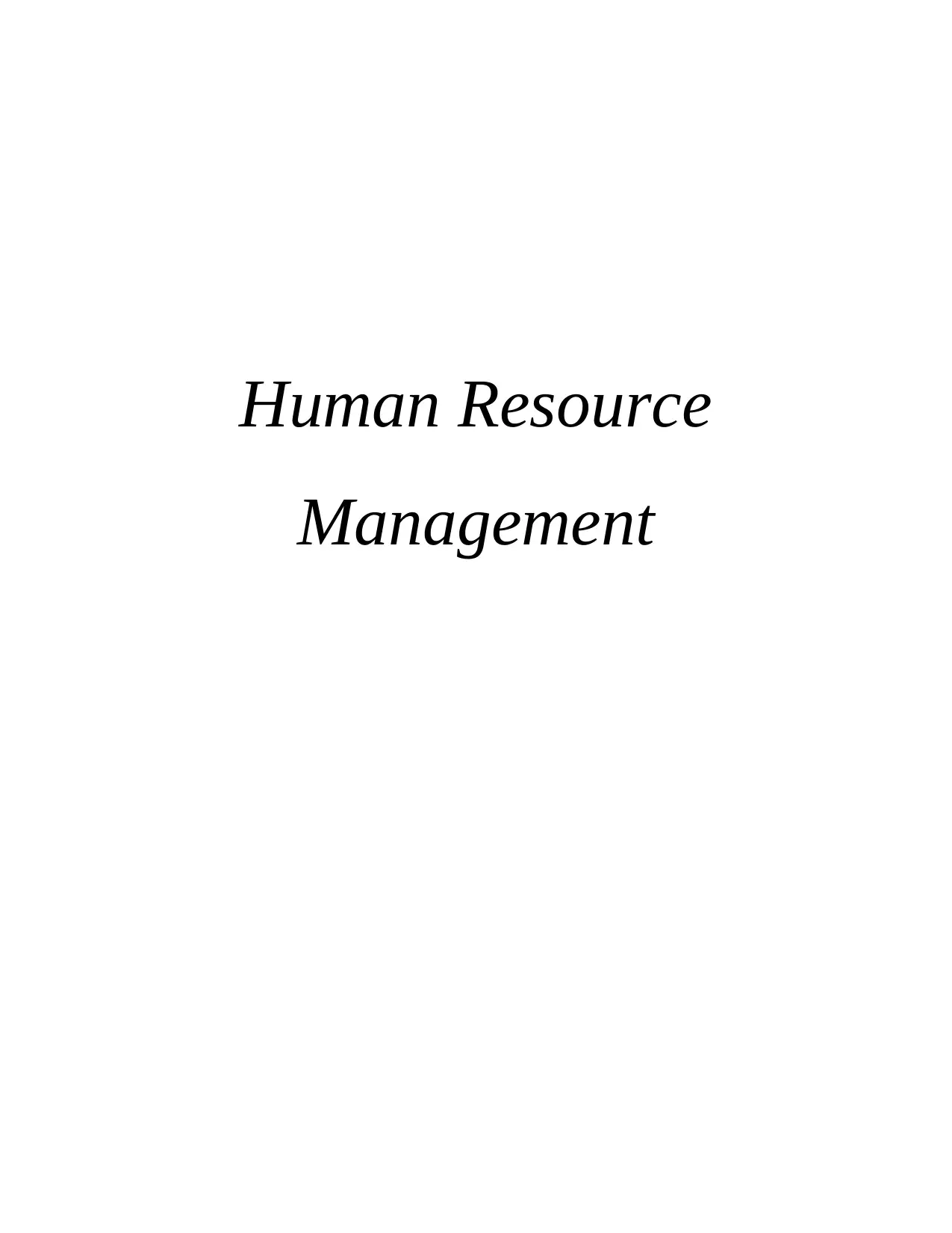
Human Resource
Management
Management
Paraphrase This Document
Need a fresh take? Get an instant paraphrase of this document with our AI Paraphraser
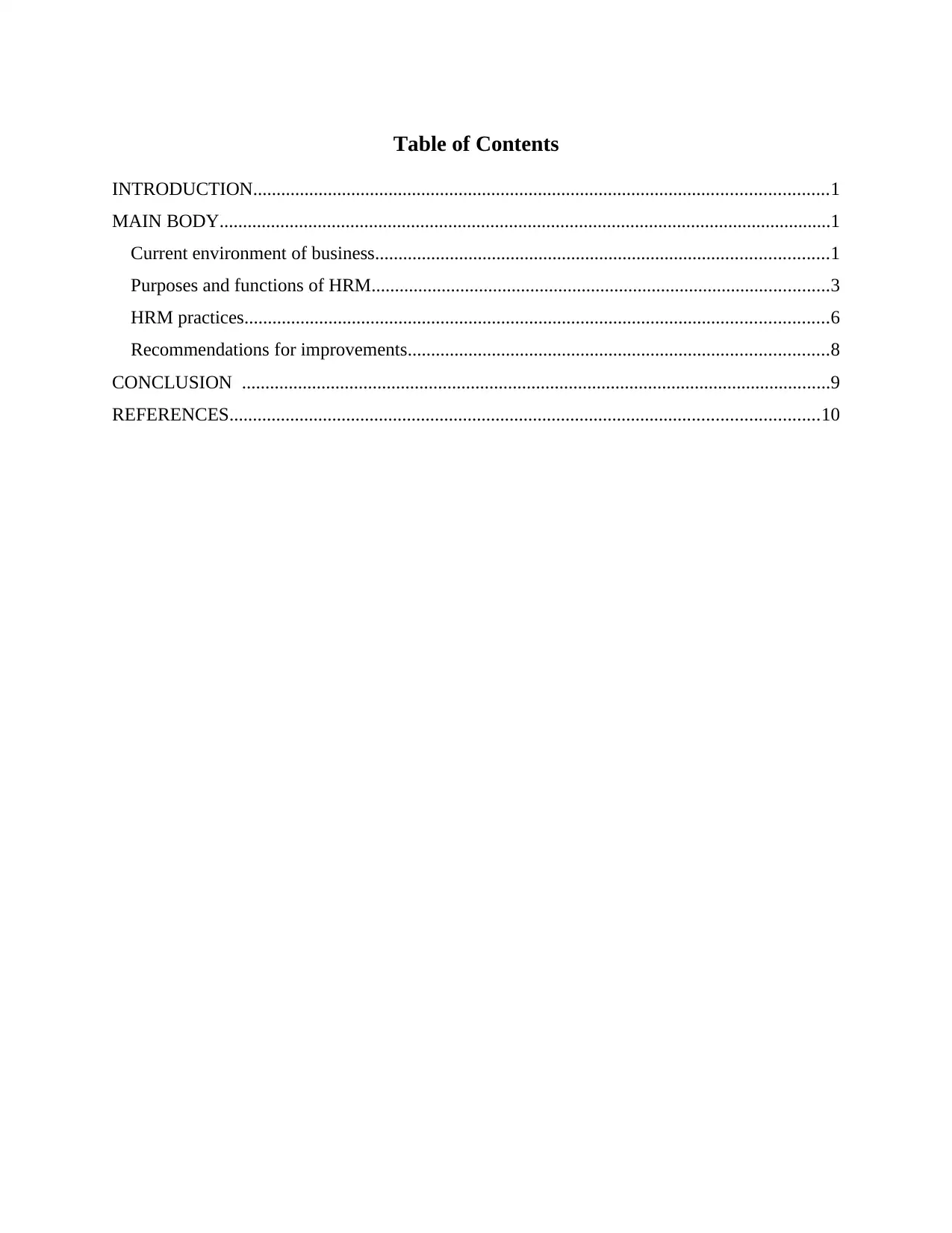
Table of Contents
INTRODUCTION...........................................................................................................................1
MAIN BODY...................................................................................................................................1
Current environment of business.................................................................................................1
Purposes and functions of HRM..................................................................................................3
HRM practices.............................................................................................................................6
Recommendations for improvements..........................................................................................8
CONCLUSION ..............................................................................................................................9
REFERENCES..............................................................................................................................10
INTRODUCTION...........................................................................................................................1
MAIN BODY...................................................................................................................................1
Current environment of business.................................................................................................1
Purposes and functions of HRM..................................................................................................3
HRM practices.............................................................................................................................6
Recommendations for improvements..........................................................................................8
CONCLUSION ..............................................................................................................................9
REFERENCES..............................................................................................................................10

⊘ This is a preview!⊘
Do you want full access?
Subscribe today to unlock all pages.

Trusted by 1+ million students worldwide
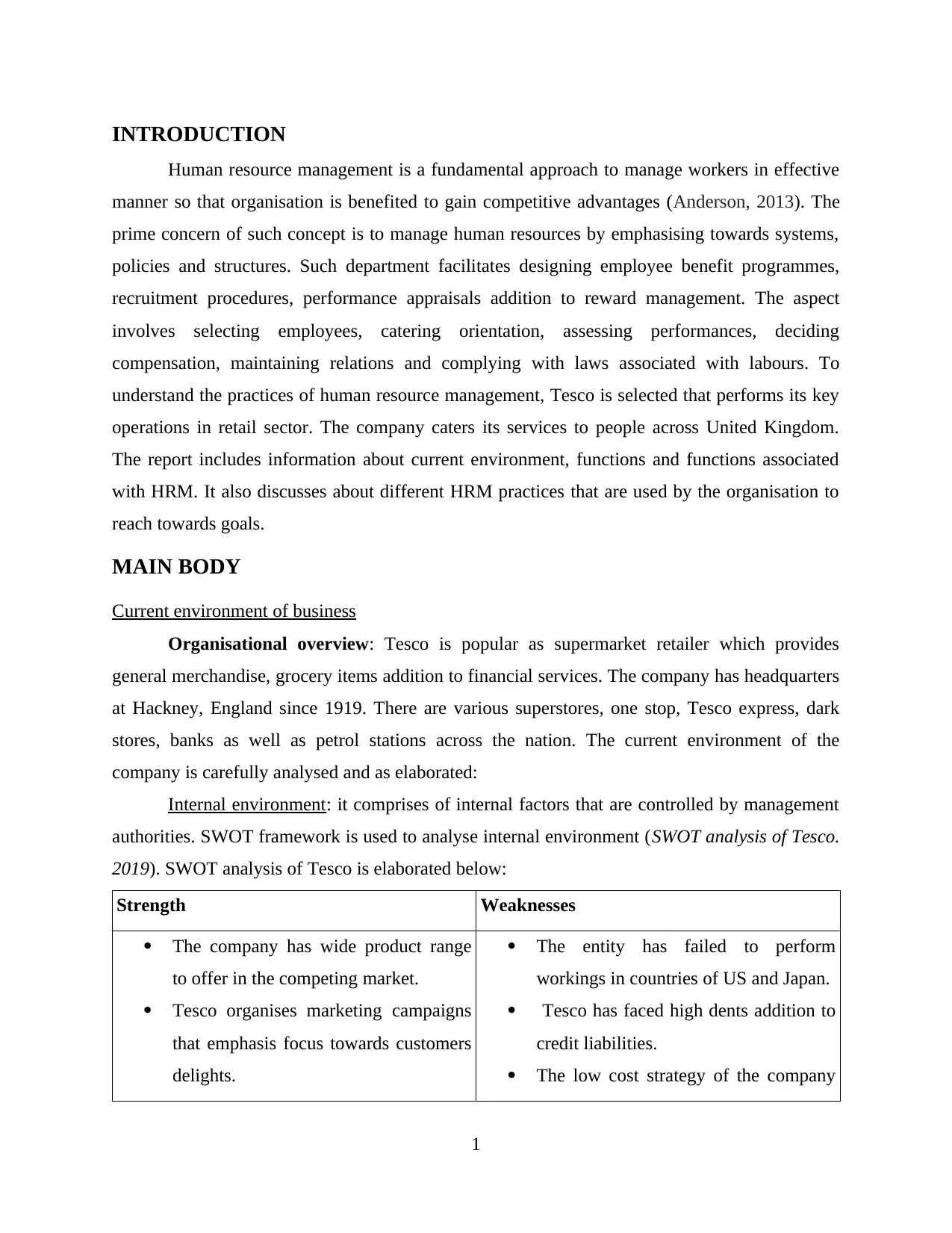
INTRODUCTION
Human resource management is a fundamental approach to manage workers in effective
manner so that organisation is benefited to gain competitive advantages (Anderson, 2013). The
prime concern of such concept is to manage human resources by emphasising towards systems,
policies and structures. Such department facilitates designing employee benefit programmes,
recruitment procedures, performance appraisals addition to reward management. The aspect
involves selecting employees, catering orientation, assessing performances, deciding
compensation, maintaining relations and complying with laws associated with labours. To
understand the practices of human resource management, Tesco is selected that performs its key
operations in retail sector. The company caters its services to people across United Kingdom.
The report includes information about current environment, functions and functions associated
with HRM. It also discusses about different HRM practices that are used by the organisation to
reach towards goals.
MAIN BODY
Current environment of business
Organisational overview: Tesco is popular as supermarket retailer which provides
general merchandise, grocery items addition to financial services. The company has headquarters
at Hackney, England since 1919. There are various superstores, one stop, Tesco express, dark
stores, banks as well as petrol stations across the nation. The current environment of the
company is carefully analysed and as elaborated:
Internal environment: it comprises of internal factors that are controlled by management
authorities. SWOT framework is used to analyse internal environment (SWOT analysis of Tesco.
2019). SWOT analysis of Tesco is elaborated below:
Strength Weaknesses
The company has wide product range
to offer in the competing market.
Tesco organises marketing campaigns
that emphasis focus towards customers
delights.
The entity has failed to perform
workings in countries of US and Japan.
Tesco has faced high dents addition to
credit liabilities.
The low cost strategy of the company
1
Human resource management is a fundamental approach to manage workers in effective
manner so that organisation is benefited to gain competitive advantages (Anderson, 2013). The
prime concern of such concept is to manage human resources by emphasising towards systems,
policies and structures. Such department facilitates designing employee benefit programmes,
recruitment procedures, performance appraisals addition to reward management. The aspect
involves selecting employees, catering orientation, assessing performances, deciding
compensation, maintaining relations and complying with laws associated with labours. To
understand the practices of human resource management, Tesco is selected that performs its key
operations in retail sector. The company caters its services to people across United Kingdom.
The report includes information about current environment, functions and functions associated
with HRM. It also discusses about different HRM practices that are used by the organisation to
reach towards goals.
MAIN BODY
Current environment of business
Organisational overview: Tesco is popular as supermarket retailer which provides
general merchandise, grocery items addition to financial services. The company has headquarters
at Hackney, England since 1919. There are various superstores, one stop, Tesco express, dark
stores, banks as well as petrol stations across the nation. The current environment of the
company is carefully analysed and as elaborated:
Internal environment: it comprises of internal factors that are controlled by management
authorities. SWOT framework is used to analyse internal environment (SWOT analysis of Tesco.
2019). SWOT analysis of Tesco is elaborated below:
Strength Weaknesses
The company has wide product range
to offer in the competing market.
Tesco organises marketing campaigns
that emphasis focus towards customers
delights.
The entity has failed to perform
workings in countries of US and Japan.
Tesco has faced high dents addition to
credit liabilities.
The low cost strategy of the company
1
Paraphrase This Document
Need a fresh take? Get an instant paraphrase of this document with our AI Paraphraser
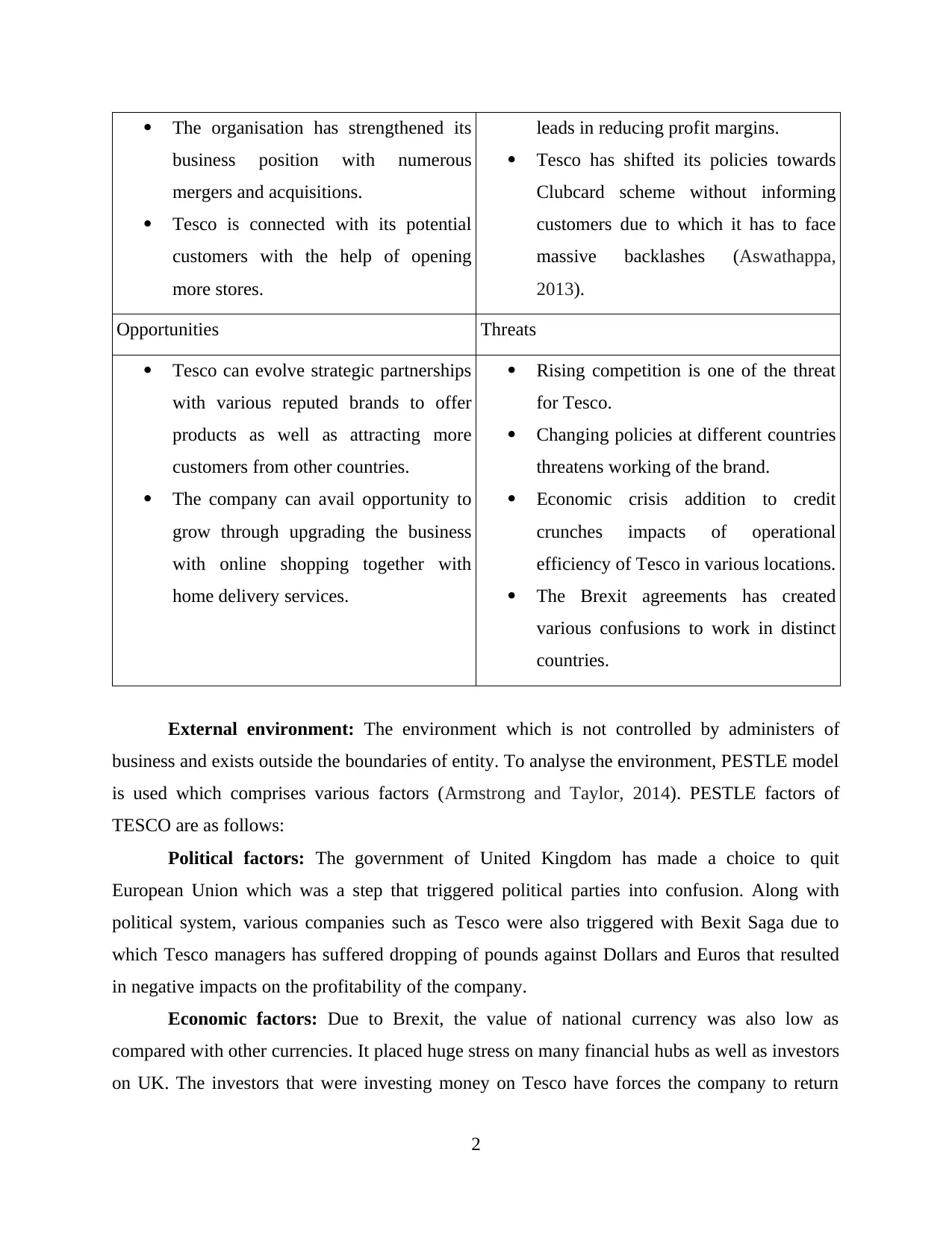
The organisation has strengthened its
business position with numerous
mergers and acquisitions.
Tesco is connected with its potential
customers with the help of opening
more stores.
leads in reducing profit margins.
Tesco has shifted its policies towards
Clubcard scheme without informing
customers due to which it has to face
massive backlashes (Aswathappa,
2013).
Opportunities Threats
Tesco can evolve strategic partnerships
with various reputed brands to offer
products as well as attracting more
customers from other countries.
The company can avail opportunity to
grow through upgrading the business
with online shopping together with
home delivery services.
Rising competition is one of the threat
for Tesco.
Changing policies at different countries
threatens working of the brand.
Economic crisis addition to credit
crunches impacts of operational
efficiency of Tesco in various locations.
The Brexit agreements has created
various confusions to work in distinct
countries.
External environment: The environment which is not controlled by administers of
business and exists outside the boundaries of entity. To analyse the environment, PESTLE model
is used which comprises various factors (Armstrong and Taylor, 2014). PESTLE factors of
TESCO are as follows:
Political factors: The government of United Kingdom has made a choice to quit
European Union which was a step that triggered political parties into confusion. Along with
political system, various companies such as Tesco were also triggered with Bexit Saga due to
which Tesco managers has suffered dropping of pounds against Dollars and Euros that resulted
in negative impacts on the profitability of the company.
Economic factors: Due to Brexit, the value of national currency was also low as
compared with other currencies. It placed huge stress on many financial hubs as well as investors
on UK. The investors that were investing money on Tesco have forces the company to return
2
business position with numerous
mergers and acquisitions.
Tesco is connected with its potential
customers with the help of opening
more stores.
leads in reducing profit margins.
Tesco has shifted its policies towards
Clubcard scheme without informing
customers due to which it has to face
massive backlashes (Aswathappa,
2013).
Opportunities Threats
Tesco can evolve strategic partnerships
with various reputed brands to offer
products as well as attracting more
customers from other countries.
The company can avail opportunity to
grow through upgrading the business
with online shopping together with
home delivery services.
Rising competition is one of the threat
for Tesco.
Changing policies at different countries
threatens working of the brand.
Economic crisis addition to credit
crunches impacts of operational
efficiency of Tesco in various locations.
The Brexit agreements has created
various confusions to work in distinct
countries.
External environment: The environment which is not controlled by administers of
business and exists outside the boundaries of entity. To analyse the environment, PESTLE model
is used which comprises various factors (Armstrong and Taylor, 2014). PESTLE factors of
TESCO are as follows:
Political factors: The government of United Kingdom has made a choice to quit
European Union which was a step that triggered political parties into confusion. Along with
political system, various companies such as Tesco were also triggered with Bexit Saga due to
which Tesco managers has suffered dropping of pounds against Dollars and Euros that resulted
in negative impacts on the profitability of the company.
Economic factors: Due to Brexit, the value of national currency was also low as
compared with other currencies. It placed huge stress on many financial hubs as well as investors
on UK. The investors that were investing money on Tesco have forces the company to return
2
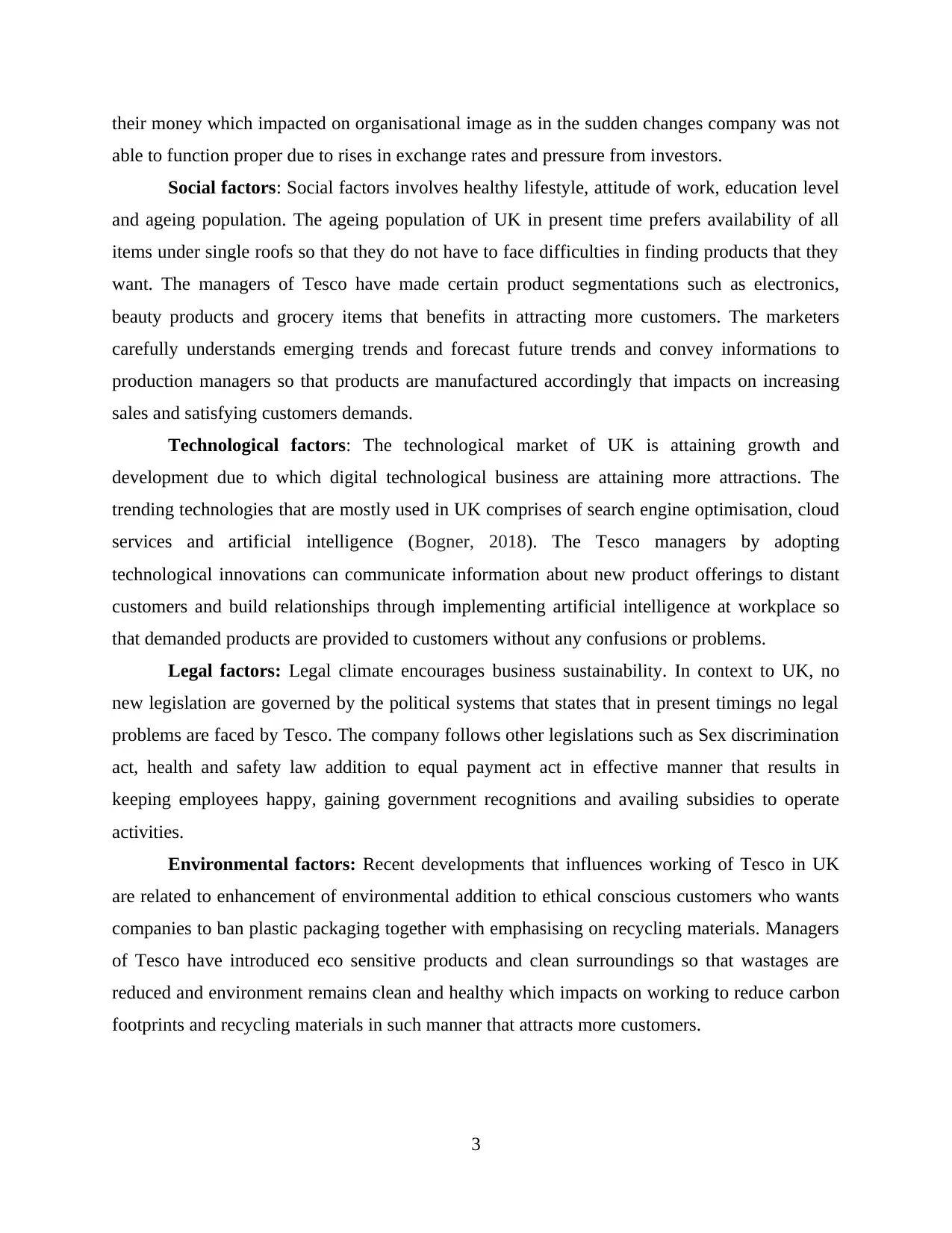
their money which impacted on organisational image as in the sudden changes company was not
able to function proper due to rises in exchange rates and pressure from investors.
Social factors: Social factors involves healthy lifestyle, attitude of work, education level
and ageing population. The ageing population of UK in present time prefers availability of all
items under single roofs so that they do not have to face difficulties in finding products that they
want. The managers of Tesco have made certain product segmentations such as electronics,
beauty products and grocery items that benefits in attracting more customers. The marketers
carefully understands emerging trends and forecast future trends and convey informations to
production managers so that products are manufactured accordingly that impacts on increasing
sales and satisfying customers demands.
Technological factors: The technological market of UK is attaining growth and
development due to which digital technological business are attaining more attractions. The
trending technologies that are mostly used in UK comprises of search engine optimisation, cloud
services and artificial intelligence (Bogner, 2018). The Tesco managers by adopting
technological innovations can communicate information about new product offerings to distant
customers and build relationships through implementing artificial intelligence at workplace so
that demanded products are provided to customers without any confusions or problems.
Legal factors: Legal climate encourages business sustainability. In context to UK, no
new legislation are governed by the political systems that states that in present timings no legal
problems are faced by Tesco. The company follows other legislations such as Sex discrimination
act, health and safety law addition to equal payment act in effective manner that results in
keeping employees happy, gaining government recognitions and availing subsidies to operate
activities.
Environmental factors: Recent developments that influences working of Tesco in UK
are related to enhancement of environmental addition to ethical conscious customers who wants
companies to ban plastic packaging together with emphasising on recycling materials. Managers
of Tesco have introduced eco sensitive products and clean surroundings so that wastages are
reduced and environment remains clean and healthy which impacts on working to reduce carbon
footprints and recycling materials in such manner that attracts more customers.
3
able to function proper due to rises in exchange rates and pressure from investors.
Social factors: Social factors involves healthy lifestyle, attitude of work, education level
and ageing population. The ageing population of UK in present time prefers availability of all
items under single roofs so that they do not have to face difficulties in finding products that they
want. The managers of Tesco have made certain product segmentations such as electronics,
beauty products and grocery items that benefits in attracting more customers. The marketers
carefully understands emerging trends and forecast future trends and convey informations to
production managers so that products are manufactured accordingly that impacts on increasing
sales and satisfying customers demands.
Technological factors: The technological market of UK is attaining growth and
development due to which digital technological business are attaining more attractions. The
trending technologies that are mostly used in UK comprises of search engine optimisation, cloud
services and artificial intelligence (Bogner, 2018). The Tesco managers by adopting
technological innovations can communicate information about new product offerings to distant
customers and build relationships through implementing artificial intelligence at workplace so
that demanded products are provided to customers without any confusions or problems.
Legal factors: Legal climate encourages business sustainability. In context to UK, no
new legislation are governed by the political systems that states that in present timings no legal
problems are faced by Tesco. The company follows other legislations such as Sex discrimination
act, health and safety law addition to equal payment act in effective manner that results in
keeping employees happy, gaining government recognitions and availing subsidies to operate
activities.
Environmental factors: Recent developments that influences working of Tesco in UK
are related to enhancement of environmental addition to ethical conscious customers who wants
companies to ban plastic packaging together with emphasising on recycling materials. Managers
of Tesco have introduced eco sensitive products and clean surroundings so that wastages are
reduced and environment remains clean and healthy which impacts on working to reduce carbon
footprints and recycling materials in such manner that attracts more customers.
3
⊘ This is a preview!⊘
Do you want full access?
Subscribe today to unlock all pages.

Trusted by 1+ million students worldwide
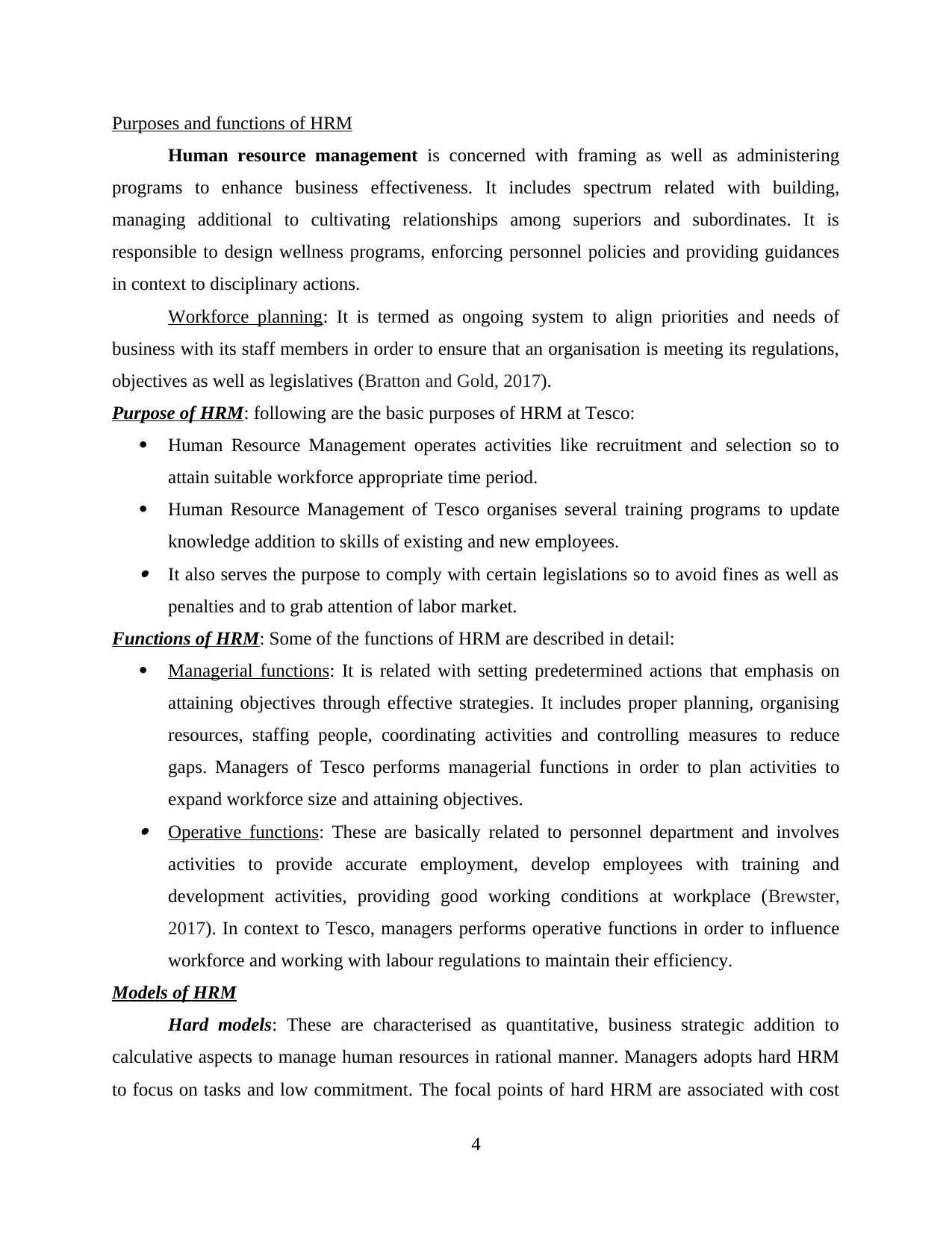
Purposes and functions of HRM
Human resource management is concerned with framing as well as administering
programs to enhance business effectiveness. It includes spectrum related with building,
managing additional to cultivating relationships among superiors and subordinates. It is
responsible to design wellness programs, enforcing personnel policies and providing guidances
in context to disciplinary actions.
Workforce planning: It is termed as ongoing system to align priorities and needs of
business with its staff members in order to ensure that an organisation is meeting its regulations,
objectives as well as legislatives (Bratton and Gold, 2017).
Purpose of HRM: following are the basic purposes of HRM at Tesco:
Human Resource Management operates activities like recruitment and selection so to
attain suitable workforce appropriate time period.
Human Resource Management of Tesco organises several training programs to update
knowledge addition to skills of existing and new employees. It also serves the purpose to comply with certain legislations so to avoid fines as well as
penalties and to grab attention of labor market.
Functions of HRM: Some of the functions of HRM are described in detail:
Managerial functions: It is related with setting predetermined actions that emphasis on
attaining objectives through effective strategies. It includes proper planning, organising
resources, staffing people, coordinating activities and controlling measures to reduce
gaps. Managers of Tesco performs managerial functions in order to plan activities to
expand workforce size and attaining objectives. Operative functions: These are basically related to personnel department and involves
activities to provide accurate employment, develop employees with training and
development activities, providing good working conditions at workplace (Brewster,
2017). In context to Tesco, managers performs operative functions in order to influence
workforce and working with labour regulations to maintain their efficiency.
Models of HRM
Hard models: These are characterised as quantitative, business strategic addition to
calculative aspects to manage human resources in rational manner. Managers adopts hard HRM
to focus on tasks and low commitment. The focal points of hard HRM are associated with cost
4
Human resource management is concerned with framing as well as administering
programs to enhance business effectiveness. It includes spectrum related with building,
managing additional to cultivating relationships among superiors and subordinates. It is
responsible to design wellness programs, enforcing personnel policies and providing guidances
in context to disciplinary actions.
Workforce planning: It is termed as ongoing system to align priorities and needs of
business with its staff members in order to ensure that an organisation is meeting its regulations,
objectives as well as legislatives (Bratton and Gold, 2017).
Purpose of HRM: following are the basic purposes of HRM at Tesco:
Human Resource Management operates activities like recruitment and selection so to
attain suitable workforce appropriate time period.
Human Resource Management of Tesco organises several training programs to update
knowledge addition to skills of existing and new employees. It also serves the purpose to comply with certain legislations so to avoid fines as well as
penalties and to grab attention of labor market.
Functions of HRM: Some of the functions of HRM are described in detail:
Managerial functions: It is related with setting predetermined actions that emphasis on
attaining objectives through effective strategies. It includes proper planning, organising
resources, staffing people, coordinating activities and controlling measures to reduce
gaps. Managers of Tesco performs managerial functions in order to plan activities to
expand workforce size and attaining objectives. Operative functions: These are basically related to personnel department and involves
activities to provide accurate employment, develop employees with training and
development activities, providing good working conditions at workplace (Brewster,
2017). In context to Tesco, managers performs operative functions in order to influence
workforce and working with labour regulations to maintain their efficiency.
Models of HRM
Hard models: These are characterised as quantitative, business strategic addition to
calculative aspects to manage human resources in rational manner. Managers adopts hard HRM
to focus on tasks and low commitment. The focal points of hard HRM are associated with cost
4
Paraphrase This Document
Need a fresh take? Get an instant paraphrase of this document with our AI Paraphraser

control, performance management, hiring and firing labours as well as formulating strategies.
Using hard models of HRM, Tesco managers understand PESTLE forces and labour market
demands while formulating strategies to complete tasks in limited time.
Soft Models: These are concerned with problematic concepts, adaptability as well as
flexibility of objectives as well as communication aspects (Thornton, 2015). These models helps
managers to focus towards people and high commitments so to achieve competitive advantages.
The focal points of Soft HRM are employee needs, workforce flexibility, participation, training,
development, motivation and strategic integration. The human resource managers of Tesco
applies Soft HRM elements while framing strategies to retain workforce and attract labour
markets.
Recruitment approaches: Recruitment involves procedures to attract, short list and appoint
prospective person for specified job. Administrators of Tesco plans all the procedures and then
follow then during recruitment process so to hire staff for distinct positions. Internal together
with external methods are used for such purpose which are as discussed:
Internal methods: Recruitment team of Tesco fills vacant positions by hiring people
from within business. Herein, initial considering to select person for specified job position is
given to existing employees. Some of the approaches are as follows:
Promotion approach: Under this, experienced employees are promoted towards higher
positions (Chelladurai and Kerwin, 2018). The promoted employees are rewarded with high
responsibilities, benefits, compensation, facilities and status.
Transfer approach: Under such approach, current employees are switched to another
jobs with same ranking and duties. The employees are shifted to one factory location to other as
per the requirement of position.
Pros and cons of internal methods of recruitment:
Pros: Such approach reduces time of recruitment team of the company to hire efficient
employees. It strengthens employee engagement and makes employee more productive by
providing them more responsibilities and compensation at Tesco.
Cons: Internal approaches results in creating inflexible culture at the company as most of
the employees for vacant position are hired from existing business only that makes them
comfortable with old workings and struggles to experiment new things.
5
Using hard models of HRM, Tesco managers understand PESTLE forces and labour market
demands while formulating strategies to complete tasks in limited time.
Soft Models: These are concerned with problematic concepts, adaptability as well as
flexibility of objectives as well as communication aspects (Thornton, 2015). These models helps
managers to focus towards people and high commitments so to achieve competitive advantages.
The focal points of Soft HRM are employee needs, workforce flexibility, participation, training,
development, motivation and strategic integration. The human resource managers of Tesco
applies Soft HRM elements while framing strategies to retain workforce and attract labour
markets.
Recruitment approaches: Recruitment involves procedures to attract, short list and appoint
prospective person for specified job. Administrators of Tesco plans all the procedures and then
follow then during recruitment process so to hire staff for distinct positions. Internal together
with external methods are used for such purpose which are as discussed:
Internal methods: Recruitment team of Tesco fills vacant positions by hiring people
from within business. Herein, initial considering to select person for specified job position is
given to existing employees. Some of the approaches are as follows:
Promotion approach: Under this, experienced employees are promoted towards higher
positions (Chelladurai and Kerwin, 2018). The promoted employees are rewarded with high
responsibilities, benefits, compensation, facilities and status.
Transfer approach: Under such approach, current employees are switched to another
jobs with same ranking and duties. The employees are shifted to one factory location to other as
per the requirement of position.
Pros and cons of internal methods of recruitment:
Pros: Such approach reduces time of recruitment team of the company to hire efficient
employees. It strengthens employee engagement and makes employee more productive by
providing them more responsibilities and compensation at Tesco.
Cons: Internal approaches results in creating inflexible culture at the company as most of
the employees for vacant position are hired from existing business only that makes them
comfortable with old workings and struggles to experiment new things.
5
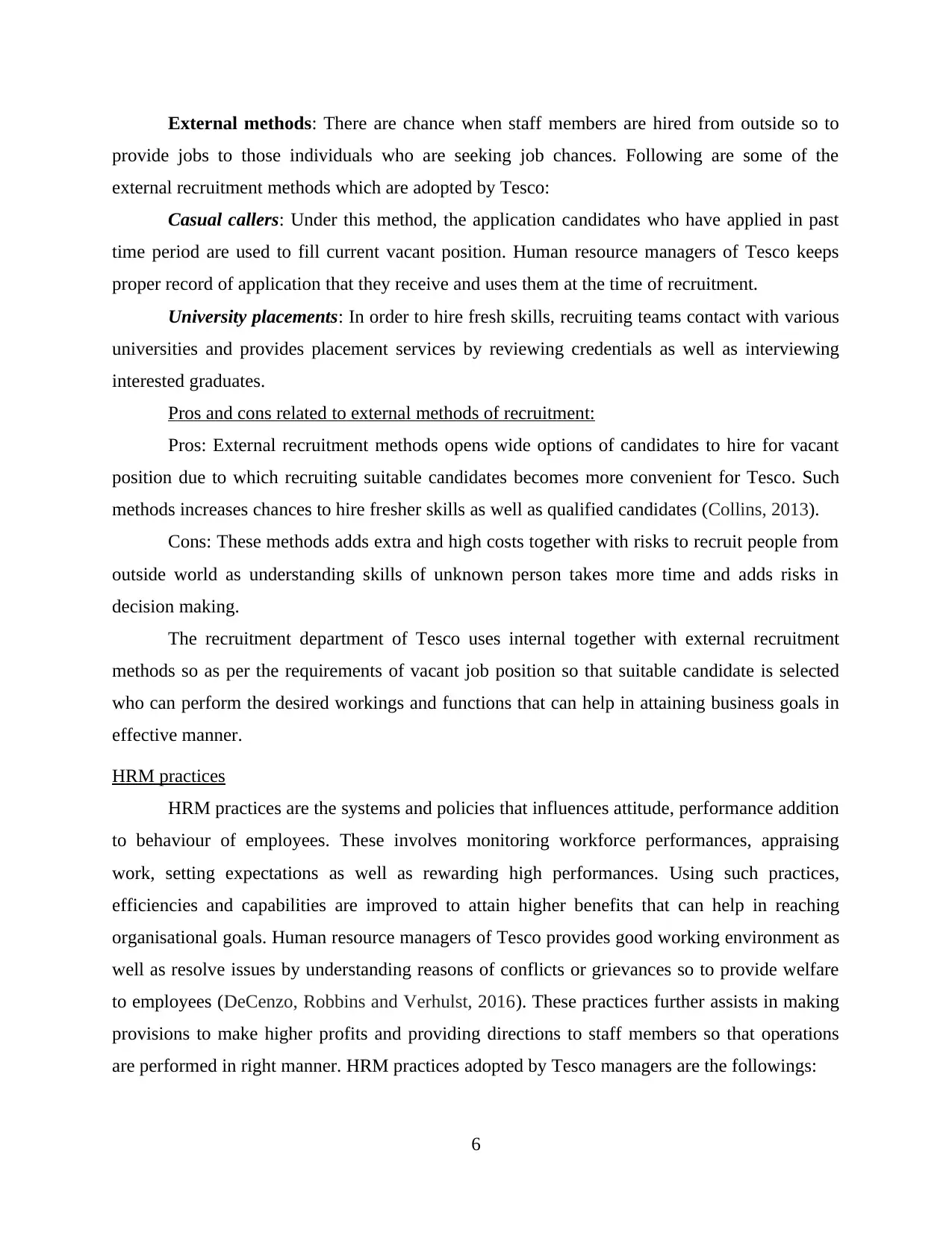
External methods: There are chance when staff members are hired from outside so to
provide jobs to those individuals who are seeking job chances. Following are some of the
external recruitment methods which are adopted by Tesco:
Casual callers: Under this method, the application candidates who have applied in past
time period are used to fill current vacant position. Human resource managers of Tesco keeps
proper record of application that they receive and uses them at the time of recruitment.
University placements: In order to hire fresh skills, recruiting teams contact with various
universities and provides placement services by reviewing credentials as well as interviewing
interested graduates.
Pros and cons related to external methods of recruitment:
Pros: External recruitment methods opens wide options of candidates to hire for vacant
position due to which recruiting suitable candidates becomes more convenient for Tesco. Such
methods increases chances to hire fresher skills as well as qualified candidates (Collins, 2013).
Cons: These methods adds extra and high costs together with risks to recruit people from
outside world as understanding skills of unknown person takes more time and adds risks in
decision making.
The recruitment department of Tesco uses internal together with external recruitment
methods so as per the requirements of vacant job position so that suitable candidate is selected
who can perform the desired workings and functions that can help in attaining business goals in
effective manner.
HRM practices
HRM practices are the systems and policies that influences attitude, performance addition
to behaviour of employees. These involves monitoring workforce performances, appraising
work, setting expectations as well as rewarding high performances. Using such practices,
efficiencies and capabilities are improved to attain higher benefits that can help in reaching
organisational goals. Human resource managers of Tesco provides good working environment as
well as resolve issues by understanding reasons of conflicts or grievances so to provide welfare
to employees (DeCenzo, Robbins and Verhulst, 2016). These practices further assists in making
provisions to make higher profits and providing directions to staff members so that operations
are performed in right manner. HRM practices adopted by Tesco managers are the followings:
6
provide jobs to those individuals who are seeking job chances. Following are some of the
external recruitment methods which are adopted by Tesco:
Casual callers: Under this method, the application candidates who have applied in past
time period are used to fill current vacant position. Human resource managers of Tesco keeps
proper record of application that they receive and uses them at the time of recruitment.
University placements: In order to hire fresh skills, recruiting teams contact with various
universities and provides placement services by reviewing credentials as well as interviewing
interested graduates.
Pros and cons related to external methods of recruitment:
Pros: External recruitment methods opens wide options of candidates to hire for vacant
position due to which recruiting suitable candidates becomes more convenient for Tesco. Such
methods increases chances to hire fresher skills as well as qualified candidates (Collins, 2013).
Cons: These methods adds extra and high costs together with risks to recruit people from
outside world as understanding skills of unknown person takes more time and adds risks in
decision making.
The recruitment department of Tesco uses internal together with external recruitment
methods so as per the requirements of vacant job position so that suitable candidate is selected
who can perform the desired workings and functions that can help in attaining business goals in
effective manner.
HRM practices
HRM practices are the systems and policies that influences attitude, performance addition
to behaviour of employees. These involves monitoring workforce performances, appraising
work, setting expectations as well as rewarding high performances. Using such practices,
efficiencies and capabilities are improved to attain higher benefits that can help in reaching
organisational goals. Human resource managers of Tesco provides good working environment as
well as resolve issues by understanding reasons of conflicts or grievances so to provide welfare
to employees (DeCenzo, Robbins and Verhulst, 2016). These practices further assists in making
provisions to make higher profits and providing directions to staff members so that operations
are performed in right manner. HRM practices adopted by Tesco managers are the followings:
6
⊘ This is a preview!⊘
Do you want full access?
Subscribe today to unlock all pages.

Trusted by 1+ million students worldwide
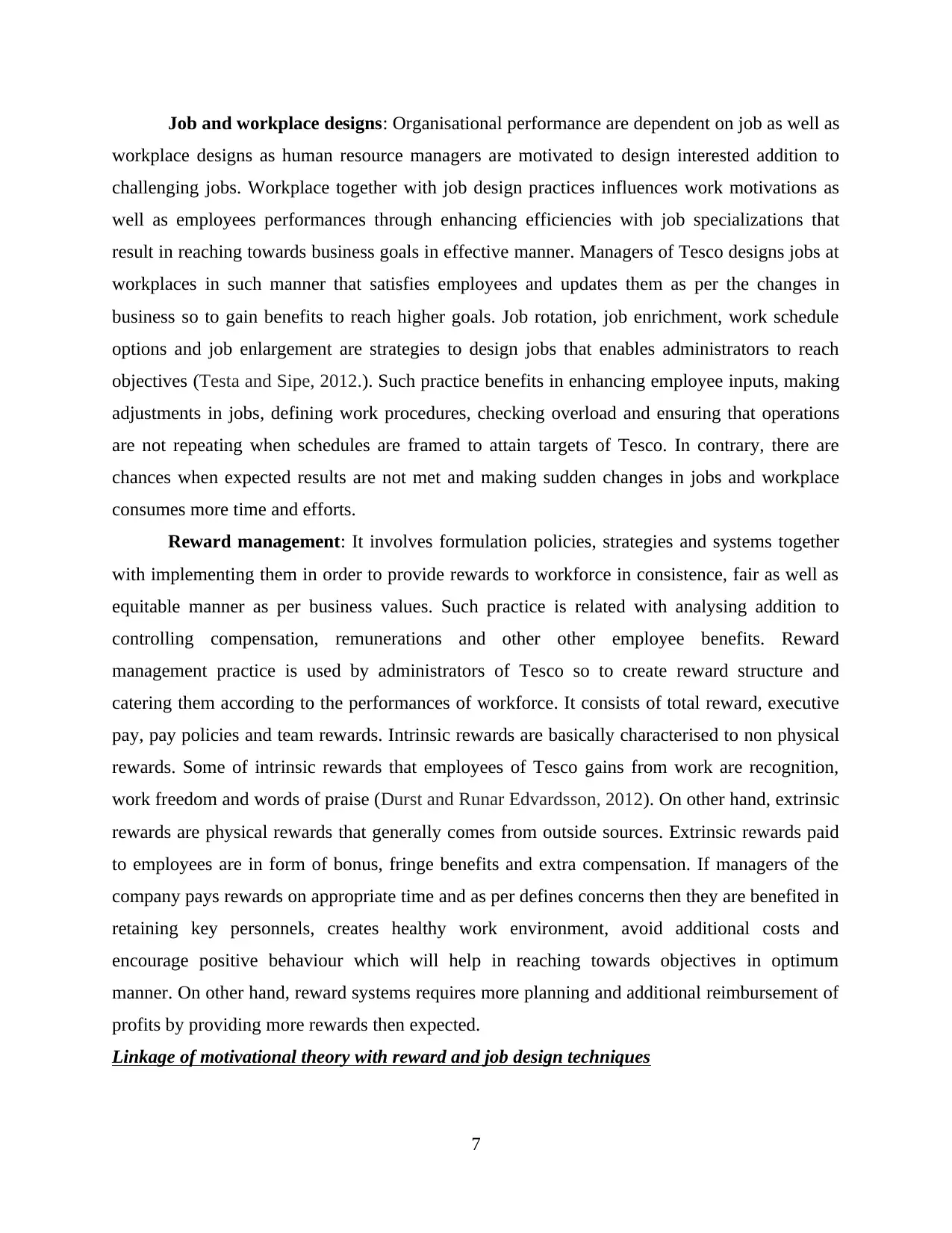
Job and workplace designs: Organisational performance are dependent on job as well as
workplace designs as human resource managers are motivated to design interested addition to
challenging jobs. Workplace together with job design practices influences work motivations as
well as employees performances through enhancing efficiencies with job specializations that
result in reaching towards business goals in effective manner. Managers of Tesco designs jobs at
workplaces in such manner that satisfies employees and updates them as per the changes in
business so to gain benefits to reach higher goals. Job rotation, job enrichment, work schedule
options and job enlargement are strategies to design jobs that enables administrators to reach
objectives (Testa and Sipe, 2012.). Such practice benefits in enhancing employee inputs, making
adjustments in jobs, defining work procedures, checking overload and ensuring that operations
are not repeating when schedules are framed to attain targets of Tesco. In contrary, there are
chances when expected results are not met and making sudden changes in jobs and workplace
consumes more time and efforts.
Reward management: It involves formulation policies, strategies and systems together
with implementing them in order to provide rewards to workforce in consistence, fair as well as
equitable manner as per business values. Such practice is related with analysing addition to
controlling compensation, remunerations and other other employee benefits. Reward
management practice is used by administrators of Tesco so to create reward structure and
catering them according to the performances of workforce. It consists of total reward, executive
pay, pay policies and team rewards. Intrinsic rewards are basically characterised to non physical
rewards. Some of intrinsic rewards that employees of Tesco gains from work are recognition,
work freedom and words of praise (Durst and Runar Edvardsson, 2012). On other hand, extrinsic
rewards are physical rewards that generally comes from outside sources. Extrinsic rewards paid
to employees are in form of bonus, fringe benefits and extra compensation. If managers of the
company pays rewards on appropriate time and as per defines concerns then they are benefited in
retaining key personnels, creates healthy work environment, avoid additional costs and
encourage positive behaviour which will help in reaching towards objectives in optimum
manner. On other hand, reward systems requires more planning and additional reimbursement of
profits by providing more rewards then expected.
Linkage of motivational theory with reward and job design techniques
7
workplace designs as human resource managers are motivated to design interested addition to
challenging jobs. Workplace together with job design practices influences work motivations as
well as employees performances through enhancing efficiencies with job specializations that
result in reaching towards business goals in effective manner. Managers of Tesco designs jobs at
workplaces in such manner that satisfies employees and updates them as per the changes in
business so to gain benefits to reach higher goals. Job rotation, job enrichment, work schedule
options and job enlargement are strategies to design jobs that enables administrators to reach
objectives (Testa and Sipe, 2012.). Such practice benefits in enhancing employee inputs, making
adjustments in jobs, defining work procedures, checking overload and ensuring that operations
are not repeating when schedules are framed to attain targets of Tesco. In contrary, there are
chances when expected results are not met and making sudden changes in jobs and workplace
consumes more time and efforts.
Reward management: It involves formulation policies, strategies and systems together
with implementing them in order to provide rewards to workforce in consistence, fair as well as
equitable manner as per business values. Such practice is related with analysing addition to
controlling compensation, remunerations and other other employee benefits. Reward
management practice is used by administrators of Tesco so to create reward structure and
catering them according to the performances of workforce. It consists of total reward, executive
pay, pay policies and team rewards. Intrinsic rewards are basically characterised to non physical
rewards. Some of intrinsic rewards that employees of Tesco gains from work are recognition,
work freedom and words of praise (Durst and Runar Edvardsson, 2012). On other hand, extrinsic
rewards are physical rewards that generally comes from outside sources. Extrinsic rewards paid
to employees are in form of bonus, fringe benefits and extra compensation. If managers of the
company pays rewards on appropriate time and as per defines concerns then they are benefited in
retaining key personnels, creates healthy work environment, avoid additional costs and
encourage positive behaviour which will help in reaching towards objectives in optimum
manner. On other hand, reward systems requires more planning and additional reimbursement of
profits by providing more rewards then expected.
Linkage of motivational theory with reward and job design techniques
7
Paraphrase This Document
Need a fresh take? Get an instant paraphrase of this document with our AI Paraphraser
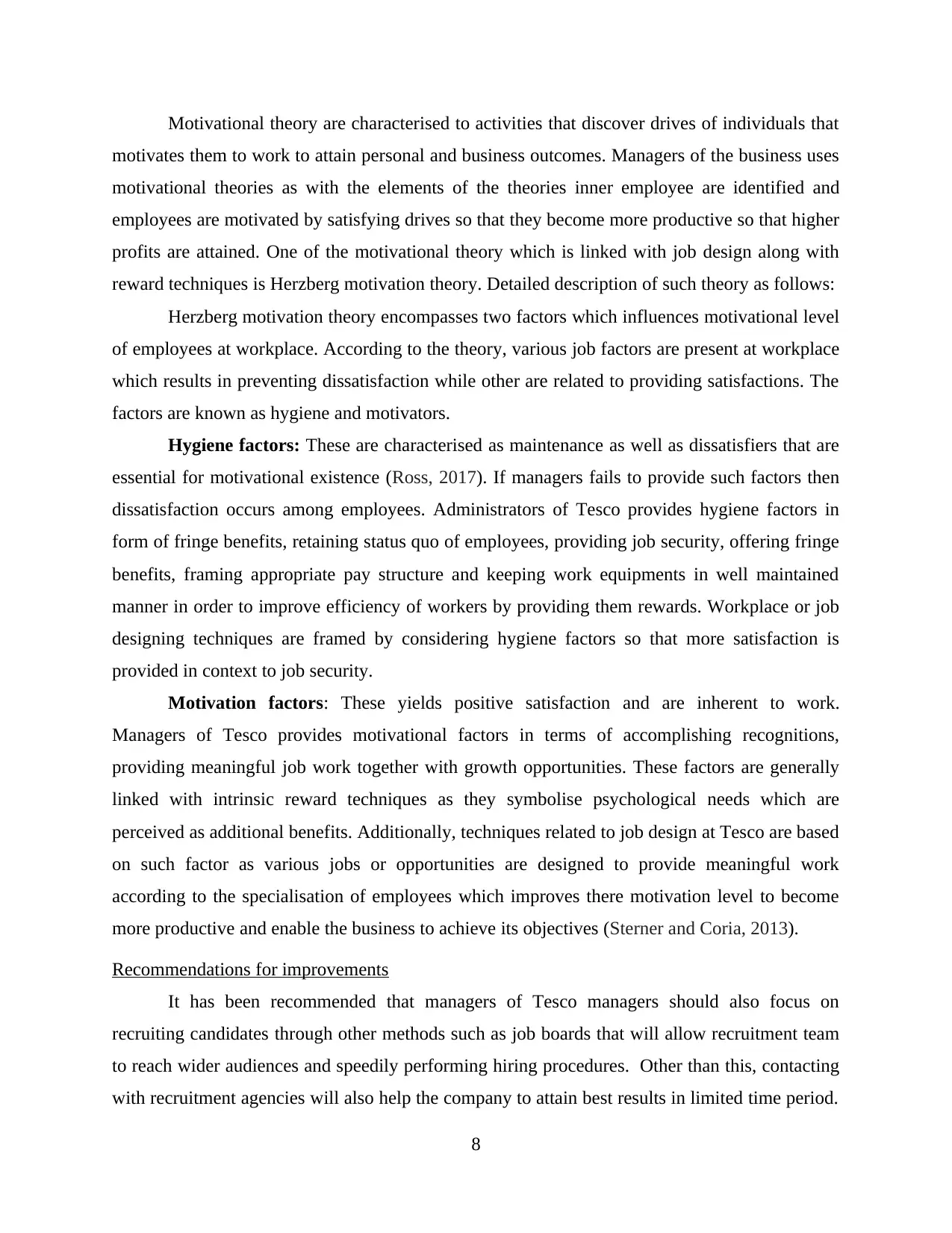
Motivational theory are characterised to activities that discover drives of individuals that
motivates them to work to attain personal and business outcomes. Managers of the business uses
motivational theories as with the elements of the theories inner employee are identified and
employees are motivated by satisfying drives so that they become more productive so that higher
profits are attained. One of the motivational theory which is linked with job design along with
reward techniques is Herzberg motivation theory. Detailed description of such theory as follows:
Herzberg motivation theory encompasses two factors which influences motivational level
of employees at workplace. According to the theory, various job factors are present at workplace
which results in preventing dissatisfaction while other are related to providing satisfactions. The
factors are known as hygiene and motivators.
Hygiene factors: These are characterised as maintenance as well as dissatisfiers that are
essential for motivational existence (Ross, 2017). If managers fails to provide such factors then
dissatisfaction occurs among employees. Administrators of Tesco provides hygiene factors in
form of fringe benefits, retaining status quo of employees, providing job security, offering fringe
benefits, framing appropriate pay structure and keeping work equipments in well maintained
manner in order to improve efficiency of workers by providing them rewards. Workplace or job
designing techniques are framed by considering hygiene factors so that more satisfaction is
provided in context to job security.
Motivation factors: These yields positive satisfaction and are inherent to work.
Managers of Tesco provides motivational factors in terms of accomplishing recognitions,
providing meaningful job work together with growth opportunities. These factors are generally
linked with intrinsic reward techniques as they symbolise psychological needs which are
perceived as additional benefits. Additionally, techniques related to job design at Tesco are based
on such factor as various jobs or opportunities are designed to provide meaningful work
according to the specialisation of employees which improves there motivation level to become
more productive and enable the business to achieve its objectives (Sterner and Coria, 2013).
Recommendations for improvements
It has been recommended that managers of Tesco managers should also focus on
recruiting candidates through other methods such as job boards that will allow recruitment team
to reach wider audiences and speedily performing hiring procedures. Other than this, contacting
with recruitment agencies will also help the company to attain best results in limited time period.
8
motivates them to work to attain personal and business outcomes. Managers of the business uses
motivational theories as with the elements of the theories inner employee are identified and
employees are motivated by satisfying drives so that they become more productive so that higher
profits are attained. One of the motivational theory which is linked with job design along with
reward techniques is Herzberg motivation theory. Detailed description of such theory as follows:
Herzberg motivation theory encompasses two factors which influences motivational level
of employees at workplace. According to the theory, various job factors are present at workplace
which results in preventing dissatisfaction while other are related to providing satisfactions. The
factors are known as hygiene and motivators.
Hygiene factors: These are characterised as maintenance as well as dissatisfiers that are
essential for motivational existence (Ross, 2017). If managers fails to provide such factors then
dissatisfaction occurs among employees. Administrators of Tesco provides hygiene factors in
form of fringe benefits, retaining status quo of employees, providing job security, offering fringe
benefits, framing appropriate pay structure and keeping work equipments in well maintained
manner in order to improve efficiency of workers by providing them rewards. Workplace or job
designing techniques are framed by considering hygiene factors so that more satisfaction is
provided in context to job security.
Motivation factors: These yields positive satisfaction and are inherent to work.
Managers of Tesco provides motivational factors in terms of accomplishing recognitions,
providing meaningful job work together with growth opportunities. These factors are generally
linked with intrinsic reward techniques as they symbolise psychological needs which are
perceived as additional benefits. Additionally, techniques related to job design at Tesco are based
on such factor as various jobs or opportunities are designed to provide meaningful work
according to the specialisation of employees which improves there motivation level to become
more productive and enable the business to achieve its objectives (Sterner and Coria, 2013).
Recommendations for improvements
It has been recommended that managers of Tesco managers should also focus on
recruiting candidates through other methods such as job boards that will allow recruitment team
to reach wider audiences and speedily performing hiring procedures. Other than this, contacting
with recruitment agencies will also help the company to attain best results in limited time period.
8
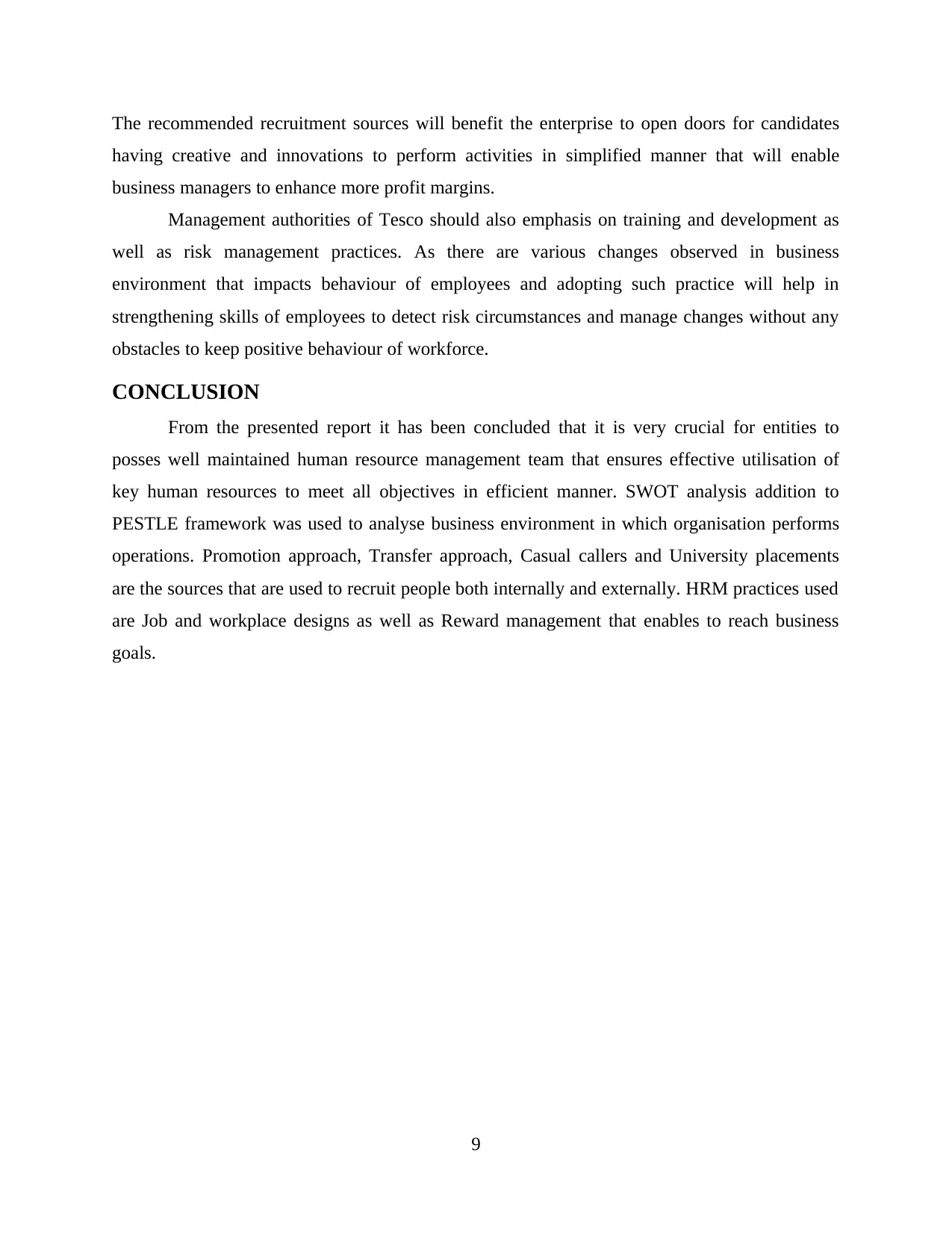
The recommended recruitment sources will benefit the enterprise to open doors for candidates
having creative and innovations to perform activities in simplified manner that will enable
business managers to enhance more profit margins.
Management authorities of Tesco should also emphasis on training and development as
well as risk management practices. As there are various changes observed in business
environment that impacts behaviour of employees and adopting such practice will help in
strengthening skills of employees to detect risk circumstances and manage changes without any
obstacles to keep positive behaviour of workforce.
CONCLUSION
From the presented report it has been concluded that it is very crucial for entities to
posses well maintained human resource management team that ensures effective utilisation of
key human resources to meet all objectives in efficient manner. SWOT analysis addition to
PESTLE framework was used to analyse business environment in which organisation performs
operations. Promotion approach, Transfer approach, Casual callers and University placements
are the sources that are used to recruit people both internally and externally. HRM practices used
are Job and workplace designs as well as Reward management that enables to reach business
goals.
9
having creative and innovations to perform activities in simplified manner that will enable
business managers to enhance more profit margins.
Management authorities of Tesco should also emphasis on training and development as
well as risk management practices. As there are various changes observed in business
environment that impacts behaviour of employees and adopting such practice will help in
strengthening skills of employees to detect risk circumstances and manage changes without any
obstacles to keep positive behaviour of workforce.
CONCLUSION
From the presented report it has been concluded that it is very crucial for entities to
posses well maintained human resource management team that ensures effective utilisation of
key human resources to meet all objectives in efficient manner. SWOT analysis addition to
PESTLE framework was used to analyse business environment in which organisation performs
operations. Promotion approach, Transfer approach, Casual callers and University placements
are the sources that are used to recruit people both internally and externally. HRM practices used
are Job and workplace designs as well as Reward management that enables to reach business
goals.
9
⊘ This is a preview!⊘
Do you want full access?
Subscribe today to unlock all pages.

Trusted by 1+ million students worldwide
1 out of 13
Related Documents
Your All-in-One AI-Powered Toolkit for Academic Success.
+13062052269
info@desklib.com
Available 24*7 on WhatsApp / Email
![[object Object]](/_next/static/media/star-bottom.7253800d.svg)
Unlock your academic potential
Copyright © 2020–2025 A2Z Services. All Rights Reserved. Developed and managed by ZUCOL.





